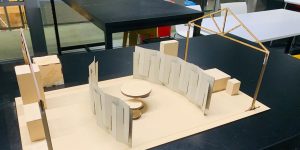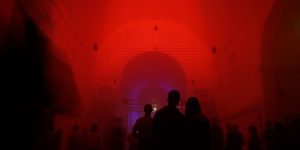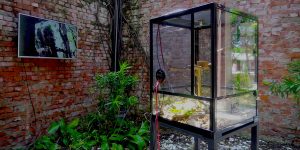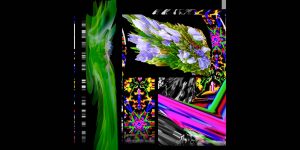exhibition

Chicago New Media 1973–1992
VGA Gallery (US)
Chicago New Media 1973–1992 chronicles the under-recognized story of Chicago's contributions to new media art by artists at the University of Illinois at Chicago's Electronic Visualization Laboratory, the School of the Art Institute of Chicago, and at Midway Games and Bally from 1973 to 1992.

TIMELESSNESS
Universidade de Lisboa, Faculdade de Belas-Artes
When Ars Electronica completes 40 years, we might be inclined to think that digital art is bound, by technology, to the time of its creation. Experiencing this selection in which drawings are excavated and expanded through augmented reality, however, a viewer’s gaze is allowed to degrade the photographic image, and the tangible or performative gestures of the audience are used to evoke memories or point to new directions. We realize that creativity can definitely transcend the technology used to build it. Calling upon temporality, space, and memory as key ingredients, Timelessness engages the participants on a journey through social, aesthetic, and temporal landscapes. The exhibition gathers artistic projects developed by undergraduate, masters, and doctoral degree students in the scope of the Multimedia Art Department of the Faculdade de Belas-Artes of the Universidade de Lisboa – FBAUL.

FUNGUAGE ROOM
Koichi Araake (JP), Eiji Iwata (JP), Michinari Kono (JP), Norio Sasaki (JP), Asa Ichinozuka (JP), BANDAI NAMCO Research Inc. (JP), Hakuhodo Inc. (JP), Ars Electronica Futurelab (AT)
How could a language between humans and objects look like? Maye like FUNGAUGE - a new form of language enabling humans and non-living material to communicate more effectively with each other. BANDAI NAMCO Group, a globally leading entertainment company, and Hakuhodo have been researching this question since 2017, together with the Ars Electronica Futurelab, building on the idea that FUN could be a universal language that transcends cultural boundaries. The current research progress and background is shown in a FUNGUAGE ROOM, where the new language is installed in a real-life environment.

LIVING WALLS – Prototype Participatory Project
Hamish Banham (AU), James Dwyer (AU), Ruth Hawkins (AU), Kelly Hodge (AU), Tom He (CH), Peter Lloyd (AU/US), Thomas Long (AU), Steven O'Hanlon-Rose (AU), William Richardson-Davis (AU), Matthew Vosten (AU)
Living Walls aims to confront and explore the possibilities and challenges associated with future living in the form of a participatory exhibit. Through an audience as a participatory agent, Living Walls aims to explore the challenges and possibilities of living in a micro-home, and provides a space for the public to explore what is important and valuable for their future living situation.

Guest Projects
Like every year at the Ars Electronica Festival, there is a series of exciting Guest Projects taking place at various locations in Linz, ranging from contributions by local art and cultural initiatives to works by artists from all over the world.

Alternative sports viewing: Cross-modal appreciation of sports events
Junji Watanabe, NTT Communication Science Laboratories (JP)
Haptic communication technology and human information science can update inclusive sports viewing. By adding a haptic sensation to the viewing experience or converting a sports video into a haptic sensation, we present a novel form of sports viewing in which the spectators whether disabled or not, can enjoy a sports event with the vicarious excitement. Junji Watanabe attempts to re-create a sports viewing experience, which does not depend on visual or auditory stimuli, as conventional sports viewing does, and in which spectators can generate alternative reality of the event. Projects of “alternative sports viewing” are presented, achieved by adding or subtracting various sensations.

Shared Habitats
The exhibition Shared Habitats focuses on the influence of technology on socio-cultural processes through fourteen works of a digital, biological, and interactive nature. The exhibition focuses on the location of organisms in their environment, the effects of humans on their habitats, and the artistic handling of new biomaterials and technologies. Many of the works on display are based on scientific experiments that are analyzed in a cultural context.

Teletext Hackathon
Nadine Arbeiter (DE), Cordula Ditz (DE), Daniel Egg (AT), Dan Farrimond (UK), Juha van Ingen (FI), Joey Holder (UK), Kathrin Günter (DE), Raquel Meyers (ES), Matthias Moos (CH), Niccolò Moronato (IT), Jarkko Räsänen (FI), Seppo Renvall (FI) and UBERMORGEN (AT/CH/USA)
At the Teletext Hackathon in the POSTCITY, five of the participating artists will create live teletext art, and the public is also cordially invited to get creative on site with teletext software. The resulting artworks can immediately be published and admired in ORF TELETEXT. The teletext exhibition ORF TELETEXT meets art will be shown in a presentation at Deep Space.

U >< N<>I<<T>> A
STATION ROSE (AT)
#Urbana Natura in_hancing_The_Augmented & vice versa is an augmented audio-visual installation, an “Out of Nature into Urban Augmented Space & Back again” exhibition. The ensemble of nature, urban and augmented spaces shows the already existing deep interweaving of these seemingly independent levels and forms of life.

KATHRIN STUMREICH hosted by ARS ELECTRONICA
Kathrin Stumreich (AT)
In the scope of this year’s Ars Electronica Festival 2019, Bildraum 07 in Vienna presents current works by Kathrin Stumreich. The artist gives insights into her sound research, in which she examines order and code, movement choreography and complex robotics, as well as coincidence and chaos as material properties.


